Ladakh, often called the “Land of High Passes,” is a dream destination for trekkers, boasting a rugged, breathtaking landscape. For those new to trekking, Ladakh offers a range of beginner-friendly treks that allow adventurers to experience its serene beauty without the challenges of strenuous, high-altitude hikes. Whether you’re looking for short, easy routes or are preparing for your first high-altitude adventure, this guide will help you navigate the easiest treks in Ladakh.
Why Ladakh is a Great Destination for Beginner Trekkers
Exploring the Unique Terrain of Ladakh
Ladakh’s landscapes are diverse and stunning, ranging from snow-covered peaks to vast, barren valleys. Despite its ruggedness, Ladakh also offers easier trekking routes for beginners, where you can enjoy its dramatic vistas without over-exertion. The region’s beginner-friendly treks are perfect for first-time trekkers who want to experience its unique combination of cultural richness and natural beauty.
Altitude Acclimatization: How to Prepare for High-Altitude Trekking
One of the most critical aspects of trekking in Ladakh is acclimatizing to the high altitude. Many of Ladakh’s treks start at altitudes above 3,000 meters (9,800 feet), so it’s important for beginners to spend a few days in Leh (Ladakh’s capital) to adjust. Proper acclimatization helps prevent altitude sickness, a common concern for first-time trekkers.
Pro tip: Spend 2–3 days in Leh to allow your body to adjust to the thin air, and drink plenty of water to stay hydrated.
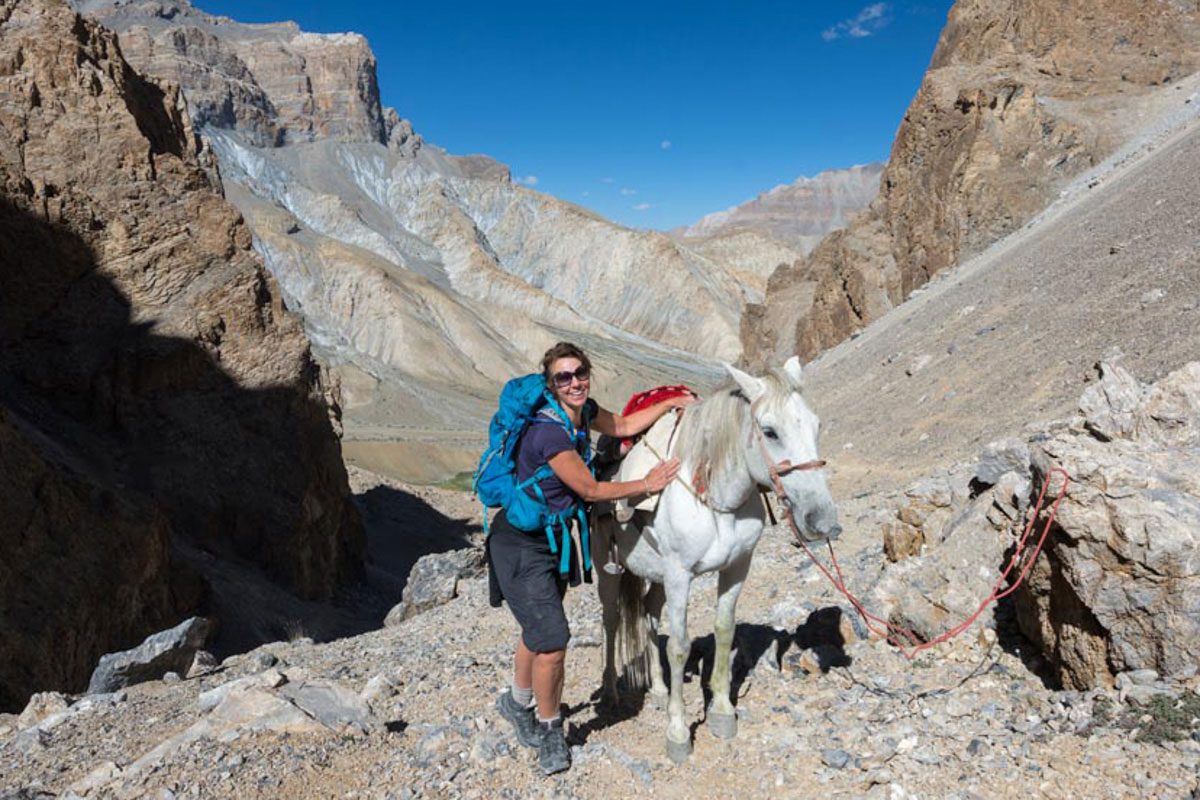
Best Time to Visit Ladakh for Trekking
The best time to trek in Ladakh is from June to September, when the weather is mild, and the trekking routes are accessible. During this period, the snow melts, revealing lush valleys and flower-filled meadows, making it perfect for easy treks in Ladakh.
| Month | Trekking Conditions |
|---|---|
| June | Clear skies, snow melting |
| July-August | Best time for treks, greenery peaks |
| September | Crisp weather, fewer tourists |
The Easiest Treks in Ladakh for Beginners
Sham Valley Trek: The Best Short Trek for Beginners
Known as the “Baby Trek of Ladakh,” the Sham Valley Trek is ideal for first-timers. It’s a short, easy trek at low altitude, allowing you to explore the local villages and ancient monasteries of Ladakh without much physical strain.
- Duration: 2–3 days
- Distance: ~30 km
- Max Elevation: 3,874 meters (12,710 feet)
- Highlights: Visit monasteries like Likir and Alchi, experience local Ladakhi culture, and enjoy panoramic views of the Indus Valley.
Why it’s perfect for beginners:
The Sham Valley trek doesn’t require high-level fitness or prior trekking experience. With gentle climbs and plenty of cultural stops along the way, it’s a great introduction to trekking in Ladakh.
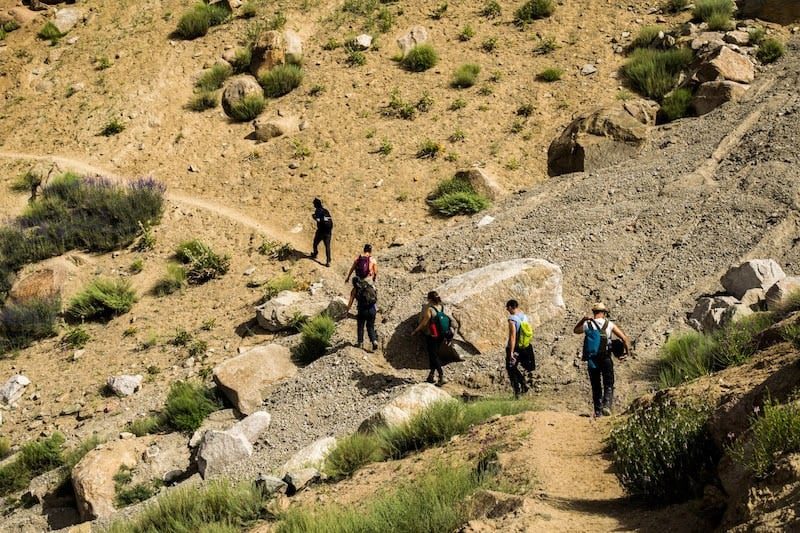
Nubra Valley Trek: A Scenic and Easy Option
The Nubra Valley Trek is known for its stunning scenery, featuring lush valleys, colorful Buddhist monasteries, and views of the majestic Karakoram Range. Despite being a longer trek, it offers mostly moderate terrain, making it a great choice for those with a bit more time and fitness.
- Duration: 5–6 days
- Distance: ~70 km
- Max Elevation: 5,602 meters (18,380 feet) at Khardung La pass
- Highlights: Crossing the famous Khardung La, seeing sand dunes in Hunder, and visiting Diskit Monastery.
Why it’s perfect for beginners:
The terrain is mostly flat once you’re in the valley, and you can often find local homestays along the way, making the trek easier to manage. Plus, Nubra’s contrasting landscapes—from cold deserts to river valleys—make it a stunning choice.
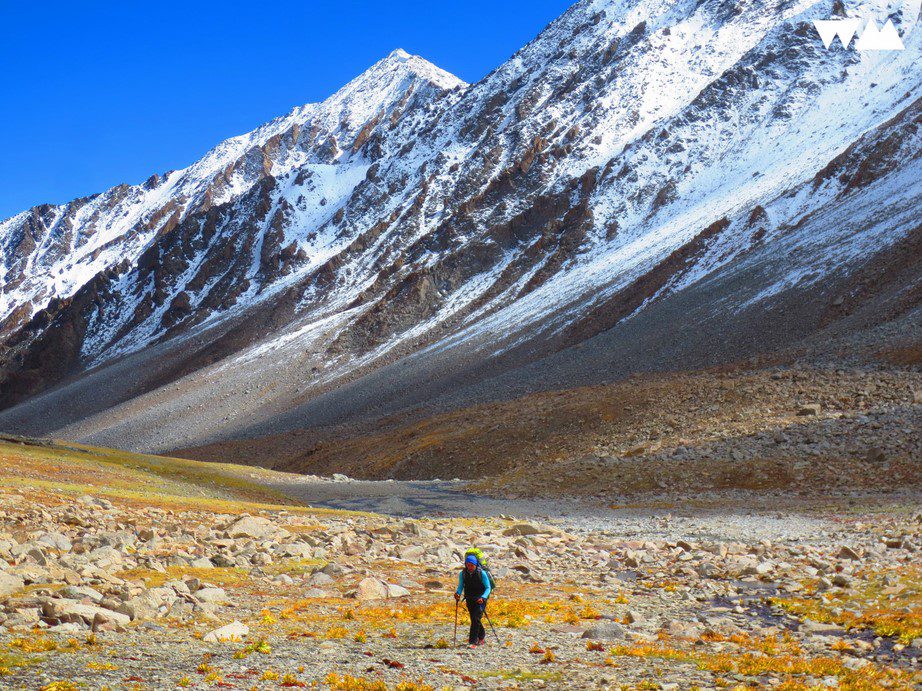
Markha Valley Trek: Moderate Yet Manageable for New Trekkers
For those who want to experience the beauty of Ladakh with a bit more challenge, the Markha Valley Trek offers a perfect blend of scenic beauty and moderate difficulty. This trek is one of the most popular routes in Ladakh, taking you through remote villages, gorges, and high-altitude passes.
- Duration: 6–8 days
- Distance: ~75 km
- Max Elevation: 5,150 meters (16,896 feet) at Kongmaru La pass
- Highlights: Stunning views of Kang Yatse peak, river crossings, and traditional Ladakhi villages.
Why it’s perfect for beginners:
Although slightly more challenging due to its length, the Markha Valley trek is ideal for beginners who are reasonably fit. The path is well-marked, and the diverse landscapes, including high-altitude deserts and green valleys, make it a rewarding journey.
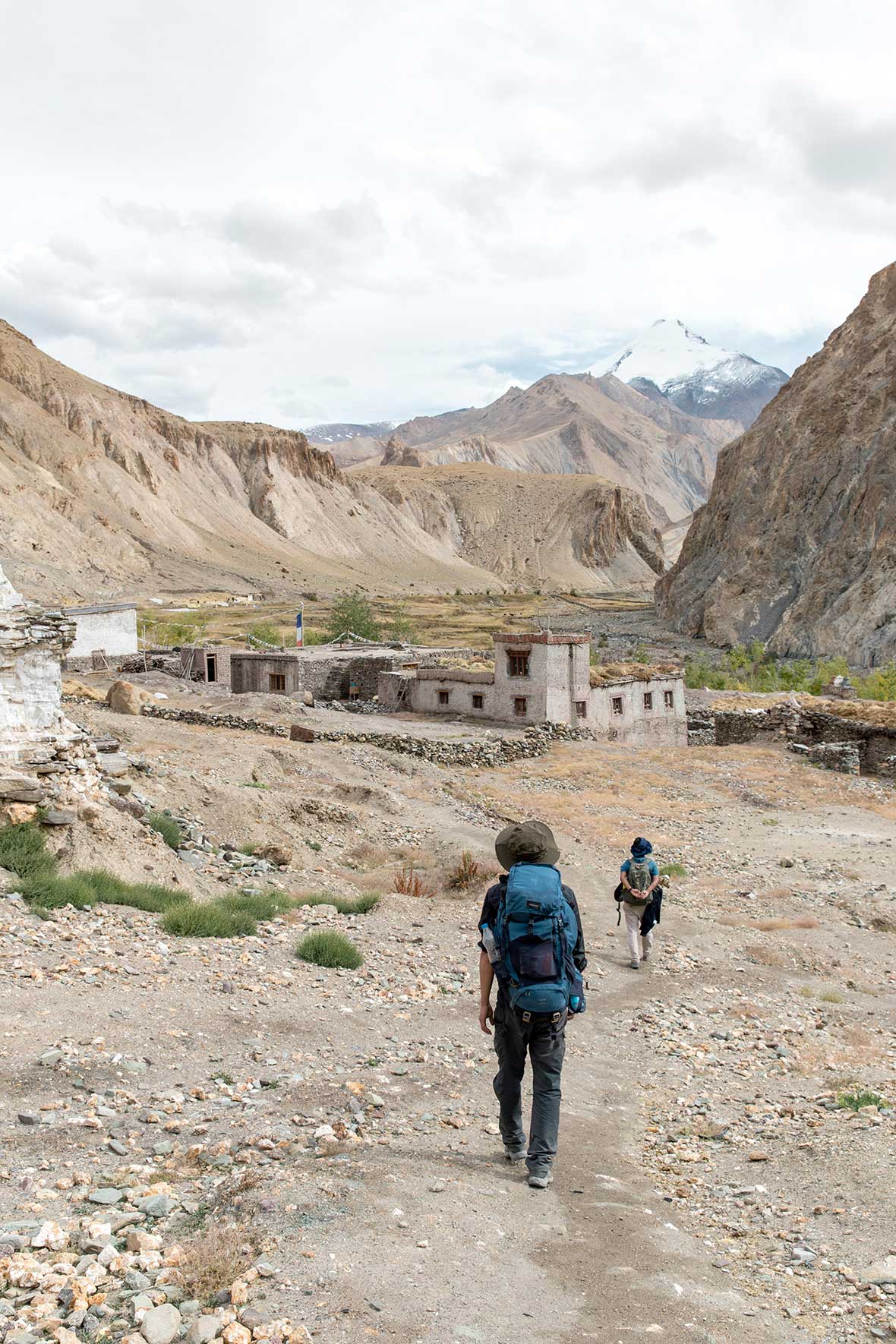
Essential Trekking Tips for Beginners in Ladakh
What to Pack for Your First Ladakh Trek
Packing smartly can make your trek more comfortable and enjoyable. Here’s a list of essentials you’ll need for an easy trek in Ladakh:
- Trekking shoes: Sturdy, waterproof, and well-broken-in boots.
- Layers of clothing: Temperature can change drastically, so pack thermal layers, a fleece jacket, and a waterproof outer layer.
- Trekking poles: Helpful for maintaining balance, especially on uneven terrain.
- Sunscreen and sunglasses: The high-altitude sun is harsh.
- Water bottles and purifier: Staying hydrated is key to avoiding altitude sickness.
- Snacks: Energy bars and dry fruits can help keep your energy levels up.
How to Train and Prepare for Ladakh Treks
Ladakh’s beginner-friendly treks don’t require a high level of fitness, but some basic preparation will make your experience more enjoyable.
- Cardio exercises: Walking, jogging, or cycling 3–4 times a week to improve stamina.
- Strength training: Focus on leg muscles with squats, lunges, and step-ups.
- Practice hikes: If possible, go on short hikes near your home to get used to trekking.
Guided Treks vs. Independent Treks: Which is Best for Beginners?
For beginners, choosing between a guided trek and trekking independently can be tricky. Let’s compare the two:
| Trek Type | Benefits | Considerations |
|---|---|---|
| Guided Trek | Expert guidance, help with acclimatization, and logistics taken care of | Costs more, less flexibility |
| Independent Trek | More freedom, can be more affordable | Need to arrange everything yourself, requires more experience |
For your first trek, a guided trek is often the safer and more convenient choice, especially if you’re unfamiliar with Ladakh’s terrain and weather conditions.
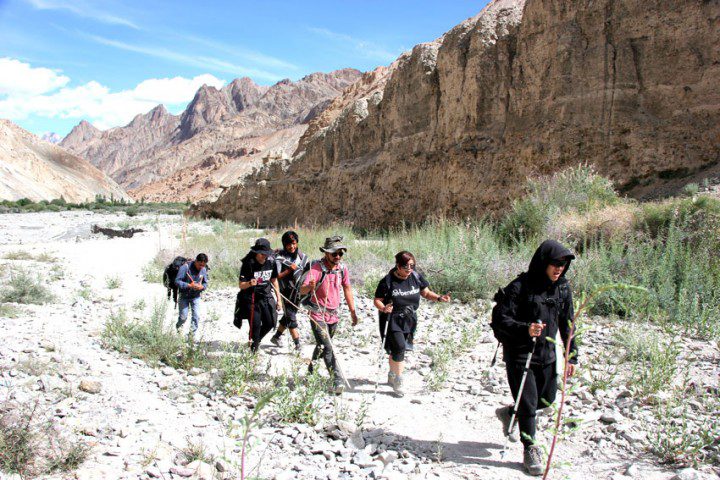
Trekking Safely: How to Ensure a Safe and Enjoyable Adventure
Understanding Altitude Sickness and How to Avoid It
Altitude sickness is a common concern for first-time trekkers in Ladakh. Symptoms include headache, nausea, and dizziness. To avoid it:
- Acclimatize properly: Spend at least 2 days in Leh before starting your trek.
- Hydrate: Drink plenty of water throughout your trek.
- Ascend gradually: Don’t rush the trek; take time to rest and enjoy the scenery.
Staying Safe on Your Trek: Basic Trekking Etiquette and Safety Tips
While trekking in Ladakh, it’s important to stay safe and respect the environment:
- Stick to marked trails: Venturing off-trail can be dangerous, especially in remote areas.
- Respect local culture: Ladakhis are deeply spiritual; be mindful of customs, especially when visiting monasteries.
- Travel in groups: It’s safer to trek with others, especially if you’re new to trekking.
The Importance of Trekking with the Right Gear
Choosing the right gear is crucial to ensure comfort and safety. Here’s a quick checklist of essential trekking gear for Ladakh:
- Backpack: A sturdy, well-fitted backpack with a rain cover.
- Headlamp: For early morning starts or unexpected night-time treks.
- First-aid kit: Include altitude sickness medication, bandages, and pain relief.
How to Plan Your Ladakh Trekking Itinerary
Creating an Ideal Itinerary for First-Time Trekkers
When planning your itinerary, make sure to include time for acclimatization, rest, and exploration. A sample itinerary for a beginner trek in Ladakh might look like this:
| Day | Activity |
|---|---|
| Day 1 | Arrive in Leh, rest and acclimatize |
| Day 2 | Explore Leh, visit monasteries, and acclimatize |
| Day 3 | Start Sham Valley Trek (drive to Likir, trek to Yangthang) |
| Day 4 | Trek from Yangthang to Hemis Shukpachan |
| Day 5 | Trek from Hemis Shukpachan to Ang, return to Leh |
Best Places to Stay During Your Ladakh Trek
Accommodation options in Ladakh range from guesthouses in Leh to homestays in villages along the trek. Homestays provide a chance to experience the local culture while offering basic amenities.
| Location | Accommodation Type |
|---|---|
| Leh | Guesthouses, hotels |
| Sham Valley villages | Homestays |
| Nubra Valley | Campsites, homestays |
Finding Affordable Trekking Packages for Beginners in Ladakh
For beginners, guided trekking packages are a great option to ensure everything is taken care of, from permits to accommodation. Look for local tour operators in Leh that offer beginner-friendly, affordable trekking packages.

Frequently Asked Questions (FAQs)
Is trekking in Ladakh safe for beginners?
Yes, there are many easy treks in Ladakh that are safe for beginners, as long as you take precautions like acclimatizing properly and staying hydrated.
What is the best trek in Ladakh for beginners?
The Sham Valley Trek is widely regarded as the best trek for beginners due to its easy terrain and cultural highlights.
How do I prepare physically for a Ladakh trek?
Focus on building stamina with cardio exercises like walking or jogging and strengthening your legs with squats and lunges.
When is the best time to trek in Ladakh?
The best time to trek in Ladakh is between June and September, when the weather is mild, and the trekking routes are accessible.
Do I need a guide for my first trek in Ladakh?
For beginners, hiring a guide is recommended to ensure safety and enjoy a more organized experience.
What should I pack for a trek in Ladakh?
Pack layers of clothing, sturdy trekking boots, a first-aid kit, trekking poles, and enough water for hydration.
Additional Q&A Section
What is the easiest trek in Ladakh?
The Sham Valley Trek is considered the easiest trek, making it perfect for beginners with minimal experience.
Can beginners do high-altitude treks in Ladakh?
Yes, but it’s essential for beginners to choose easier routes and ensure they acclimatize properly to avoid altitude sickness.
How long does it take to complete a beginner trek in Ladakh?
Most beginner treks in Ladakh, like the Sham Valley Trek, can be completed in 2–3 days.
Do I need special permits for trekking in Ladakh?
Yes, some areas in Ladakh require Inner Line Permits (ILP), which can be easily obtained in Leh.
What’s the best way to get to Leh?
The easiest way to get to Leh is by flight, although you can also reach it by road from Manali or Srinagar.
Is it possible to camp during beginner treks in Ladakh?
Yes, camping is possible along many trekking routes, but there are also homestays and guesthouses available for accommodation.
Conclusion
Ladakh offers an incredible array of trekking options for beginners. Whether you’re looking for short, easy routes or slightly more challenging treks, the region’s stunning landscapes and rich culture make it an unforgettable destination. With proper preparation, the right gear, and a willingness to acclimatize, even first-time trekkers can enjoy Ladakh’s breathtaking beauty.








